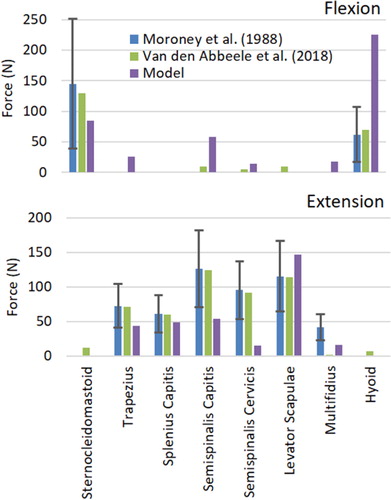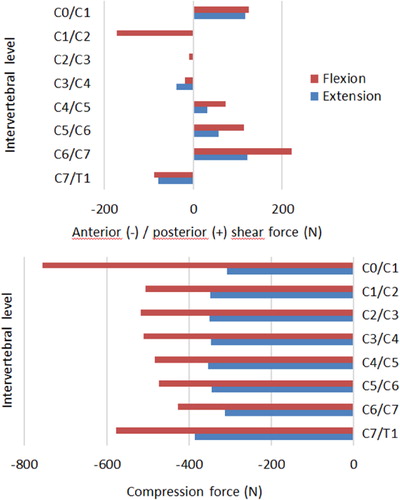1. Introduction
Task related estimation of the musculo-tendon and intervertebral forces in the neck can help gaining some insights on the role of the central nervous system and in assessing cervical spine disorders. Musculoskeletal models have been developed to solve the muscular redundancy and estimate these forces, generally based on a static equilibrium computed at the level of the C4/C5 joint, e.g., (Moroney et al. Citation1988; Van den Abbeele et al. Citation2018). However, solving the equilibrium of the entire cervical spine system is essential to be able to evaluate its muscular response (including from its numerous multi-level muscles) as well as the loads transmitted to the vertebrae and inter-vertebral discs.
This study investigates the distribution of the intervertebral compression and shear forces in the cervical spine during two isometric maximum voluntary contractions (MVC) tasks, toward neck flexion and extension. The forces at the C4/C5 joint and the musculo-tendon forces of 8 muscle groups are compared with the results of two other neck models reported in the literature.
2. Methods
2.1. Neck musculoskeletal model
A musculoskeletal model of the cervical spine including the skull (C0), cervical vertebrae (C1–C7), and thorax was created based on a comprehensive anatomical and geometrical dataset (Borst et al. Citation2011). The hyoid bone and thyroid cartilage were considered part of the skull. The model includes 252 muscle lines of action representing 34 symmetric pairs of muscle groups. It was parameterised using natural coordinates, and Lagrange multipliers corresponding to the spherical joint constraints were introduced in the objective function to simultaneously minimise musculo-tendon and intervertebral forces. Musculo-tendon forces were bound by a maximum of 60 times the physiological cross sectional area.
2.2. Simulation of isometric tasks
Mean moment applied to the neck at the C4/C5 joint during isometric MVC toward neck flexion and extension (resp. 12.8 N.m and -25.9 N.m) (Moroney et al. Citation1988), were transformed into horizontal forces at the level of the skull centre of mass to be applied to the entire musculoskeletal model.
The estimated intervertebral compression and shear forces at C4/C5, as well as 8 musculo-tendon forces, were then compared with the results of two other neck models (Moroney et al. Citation1988; Van den Abbeele et al. Citation2018). In the present model, the forces obtained in the different lines of action of a same muscle (or muscle group) were summed up.
3. Results and discussion
The recruitment patterns () presented some similarities between studies. The main forces were predicted in the sternocleidomastoid and hyoid muscles in flexion and in the semispinalis capitis, semispinalis cervicis, and levator scapulae muscles in extension. Differences in the magnitudes of the hyoid muscles forces could be explained by different modelling hypotheses regarding these muscles in the three models. Although sometimes not accounted for, these muscles may have a significant contribution in flexion tasks (Lamouri and Fréchède Citation2013).
The compression and shear forces at the C4/C5 joint () were comparable for the flexion but the present model predicted remarkably lower compression and shear forces for the extension. This could be due to the consideration of the entire cervical spine system equilibrium, to the high number of muscle lines of actions or to the simultaneous minimisation of musculo-tendon and intervertebral forces (although this was also the case in one of the compared model (Van den Abbeele et al. Citation2018), moments were directly applied at the C4/C5 in this previous study). The importance of considering the entire cervical spine system equilibrium was already underlined in the literature, with a model based on the same comprehensive dataset (de Bruijn et al. Citation2016).
Table 1. Intervertebral forces at the C4/C5 joint.
Similarly to this latter model but conversely to other ones (Moroney et al. Citation1988; Van den Abbeele et al. Citation2018), the present model allows for a simultaneous analysis at all intervertebral levels (). Similar force distributions were found between the intervertebral levels in flexion and extension, although the muscle recruitments () were different. The lowest shear forces were predicted at C2/C3 level while the lowest compression forces were at the C6/C7 level. As fewer multi-articular muscles were recruited for flexion, higher shear and compression forces appeared, especially in the upper cervical spine. C1/C2 was remarkably loaded with a prediction of −171 N in anterior shear force.
4. Conclusions
Musculo-tendon and intervertebral forces (at the C4/C5 joint level) estimated during isometric tasks can differ from one model to another. Considering the entire cervical spine system gives access to the distribution of the intervetebral forces, which appears somewhat consistent between simulated isometric MVC tasks toward neck flexion and extension.
References
- Borst J, Forbes PA, Happee R, Veeger D. 2011. Muscle parameters for musculoskeletal modelling of the human neck. Clin Biomech. 26(4):343–351.
- de Bruijn E, van der Helm FCT, Happee R. 2016. Analysis of isometric cervical strength with a nonlinear musculoskeletal model with 48 degrees of freedom. Multibody Syst Dyn. 36(4):339–362.
- Lamouri P, Fréchède B. 2013. Evaluation of neck muscles activation patterns during simple isometric tasks. Comput Methods Biomech Biomed Eng. 16(sup1):170–171.
- Moroney SP, Schultz AB, Miller J. 1988. Analysis and measurement of neck loads. J Orthop Res. 6(5):713–720.
- Van den Abbeele M, Li F, Pomero V, Bonneau D, Sandoz B, Laporte S, Skalli W. 2018. A subject-specific biomechanical control model for the prediction of cervical spine muscle forces. Clin Biomech. 51:58–66.


